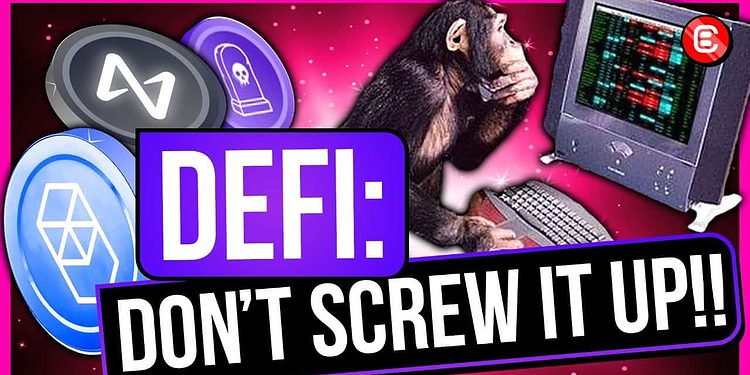Two weeks ago, I went full degen-ape and put “found” money into high-risk Tomb forks. This is what I learned.
Irrational optimism can be great; it’s why only about 15 percent instead of 99 percent of humans get clinically depressed — Robert M. Sapolsky
A recap and a correction
In my last article, I went against my own crypto investing philosophy and put money in 3omb and Ripae. If you’ve been on the sidelines wondering what all the hype is about, this might be a good place to start before you jump into these high-risk/high-reward pools.
In terms of the correction, I double-counted tokens somewhere along the way. I thought I had gone from 425 Fantom (FTM) to 720 FTM, but it was actually closer to 600 FTM. Not bad, but not quite the “double” I had claimed in the article.
After I published the article, I pulled my profit off Ripae and let about $120 worth of PAE (the share token) ride. I briefly moved my 3omb/WFTM pair to 2omb/FTM, but ended up pulling that the next day. I got lucky on that one I think.
I woke up and found 2omb liquidity had dropped from $110 million to around $80 million and the 2omb peg had fallen to around 0.87. Prior to that moment, I had felt somewhat safe with the (seemingly) large liquidity pool on 2omb.
I reasoned it would give me enough time to bail if something went haywire. To be fair, it did give me some reaction time, but $30 million in liquidity disappeared a lot faster than I thought it could.
I saw the news about Russia and Ukraine about an hour later. By then, the 2omb and 3omb pegs had totally collapsed. Both were somewhere between .35 and .5 (it’s supposed to be 1:1 with FTM). My 600ish FTM was now around 520 after I unwound that position.
Still up though 🙂
I am a 100% supporter of the Fantom Opera chain. I think it has enormous growth potential. It also strained pretty hard under the massive upswing in transactions. Transaction times went from a couple of seconds to a few minutes and the fees basically 10x’d.
The beauty of Fantom is, I was complaining about having to pay $0.45 a transaction. “This is ridiculous!” I thought, completely forgetting all the transactions on Ethereum that took three hours and cost me $50. It reminded me of this little comedy bit by Louis C.K.
Fantom has definitely spoiled me (or, spoilt for my British friends). I can also see they need to scale up pretty fast if adoption rates start going up.
Tomb forks are like a boomer on a hoverboard
As long as people are standing around holding Grandpa up, he’s stable. The second they let go, Grandpa is probably going to need a new hip. And that is why I bailed at the first sign of trouble with 2omb. It’s not stable.
The selling point for me was the idea that T2|3 was a stablecoin that is pegged to Fantom. I like Fantom. I want to stack Fantom. This seemed like an interesting way to do so while reducing the risk of impermanent loss.
3omb actually says this on their homepage:
Image: 3omb Finance
From a plain-meaning standpoint, if a token drops peg by over 50%, it is neither stable, nor pegged. The founders cleared this up in their AMA though. They said the bonding/treasury mechanism is to help, but the peg requires the community (statement at 00:14:50).
Uhm…no.
The documents very clearly say the Share brings over-peg down, Bonds bring under-peg up, and the DAO (Treasury) is a “second-line” of defense against downward sell pressure (extreme under-peg). They apparently deployed the Treasury to the tune of a $500k buyback that did… well, nothing.
The markets let go of Grandpa 2omb|3omb and he went splat. Tomb held peg the whole time. They also have a billionaire backer, $600 million in total value locked (TVL), and a massive Treasury.
And Tomb Finance is more honest on their site. No claims about “pegs” or “stablecoins”, just this:
Image: Tomb Finance
Which is mostly fair. The simple fact is, without Treasury intervention, the Bonding mechanism doesn’t work. Full stop. If the Treasury doesn’t have enough money to maintain the peg, it can collapse under sell pressure from an external shock.
Bear in mind, the external shock that blew up the T2|3 peg was a relatively poor country invading a really poor country that used to be basically the same country (the USSR). In terms of overall geopolitical market risk, it seems the markets kinda burped a little and kept right ongoing.
The broader crypto market seems to be slowly recovering as well, but 2omb|3omb still hasn’t hit their peg as of this writing. 2omb is slowly climbing back. 3omb is having a harder time at it. For perspective, the Iron Bank “stablecoin” was off by 50% when that protocol collapsed.
Ripae has never been at peg, but it’s always been way over. Their share price took a huge dump though AND they found a bug in the Treasury code that was letting a hacker drain funds unchecked.
Oops.
Tomb fork takeaways
Rather than drone on and on, I’ll break out my findings/thoughts into a list:
- Share prices are extremely vulnerable to whale action. Whales can very easily initiate a pump, which brings the baboons. Then they dump when their lock expires. If you don’t think it’s true, just look at the deposits and withdrawals on FTMscan during both the 2Share and 3Share pumps. Hell, just look at the chart, it’s pretty obvious. Let the baboons eat cake, “mirite”?
- Bonds are a total failure. Redemption rewards are not big enough to risk locking tokens indefinitely. If under peg, it is FAR safer to wait for the peg to return vs. locking in a bond. If the peg never comes back, bond funds are gone forever, but at least you can (hopefully) cut losses if hodling.
- Low TVL leaves the entire protocol vulnerable to external shocks and price manipulation. TVL at $500 million+ is only a buffer to extreme price action. A big enough shock will drain that pool too, and there’s nothing left to backstop it, except the community (and maybe a billionaire VC). Just remember, the community we’re talking about are a bunch of baboons chasing 3,000% annual percentage rates (APR) – myself included.
- The protocol over-relies on users understanding the protocol. This is just a theory, but my guess is many baboons bought up 2omb/3omb/pFTM because they expected a pump, failing to recognize the protocol is actively (trying) to push the price down. Baboons are skittish and they’ll bail fast. “Wen moon bruh?”
- Amateur coders are deploying untested code in the wild. The “teams” creating these forks are (often) not even remotely qualified to deploy these contracts in a live setting with real money on the line. You might very well be “investing” in a protocol launched by two kids chatting over Discord while taking rips off their bong.
- I’m still on the fence about auto-compounders. Devil Finance, Beefy Finance, Grim Finance (recently hacked), Liquid Driver, et al., these are all very much in the Alpha/Experimental phase. If you can’t tell, I don’t think Tomb forks are viable to begin with (without MAJOR protocol changes anyway). I can’t see how adding significant code complexity/risk on top of that is a good idea, but YMMV. I’m keeping my fingers out of that hole.
- Despite it all, I’m still in Tomb. Harry Yeh is a smart guy. I have no doubt he saw what happened with his new “partners” over at T2|3, and is working on a fix for this stuff. Time will tell, but I think changes to the bonding mechanism might bring stability. In the meantime, I’m still pretty stoked with my 95% APR. In Harry We Trust, right?
But I want my APR!
Terra/Anchor, AAVE, Planet Finance, Curve, etc. Pair, single stake, and/or lend stablecoins (actual stablecoins) or single sides (only one side of the pool), earn 4–35%(+), and be happy. Just FYI, these are AMAZING returns for holding xUSDx or tokens you like anyway.
Or
Consensus stake. NEAR, Fantom, Polygon, Terra (and many others) all offer staking pools whose sole function is to validate transactions. Easy 8–15% APRs for parking tokens you like anyway with technically skilled network engineers running servers. Staking-as-a-service is a thing and it’s growing daily. Easy money, with a tiny slash risk (if the server goes down or prints a bad block).
And for the love of God, pretty please, with sugar on top, do not lever (borrow) to invest in other stuff. I can say with absolute certainty, a truck-ton of people got liquidated last week. A token dropping in price sucks, but a liquidation is forever. On the flip side, buying liquidations is quite literally free money if you play your cards right. Baboons are terrible at cards.
Of course, these are just my opinions. I’m not a financial advisor, this isn’t financial advice, and always do your own research (DYOR). Following any of these ideas might cause you to lose all of your money. I am 100% serious about that. I like tinkering with this stuff, but I’m now on record acting like a total baboon. Invest accordingly.
Until next time, be safe, be smart and be sure to tie the camel.
Written by DL White JD, LLM, MSc
“An objective, evidence-based exploration of crypto and finance.”
Twitter: https://twitter.com/tinmoneytv
Medium: https://tinmoney.medium.com/







